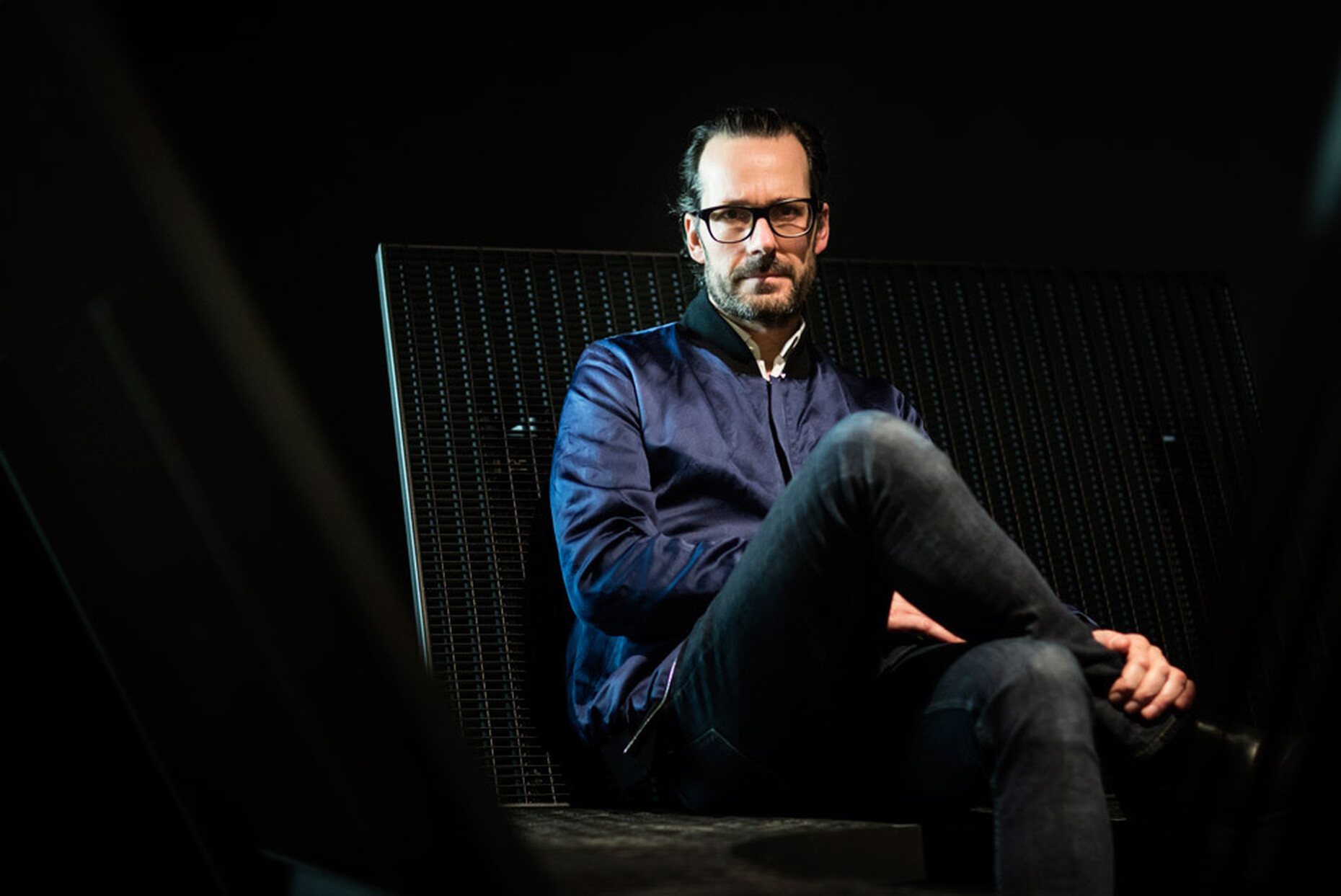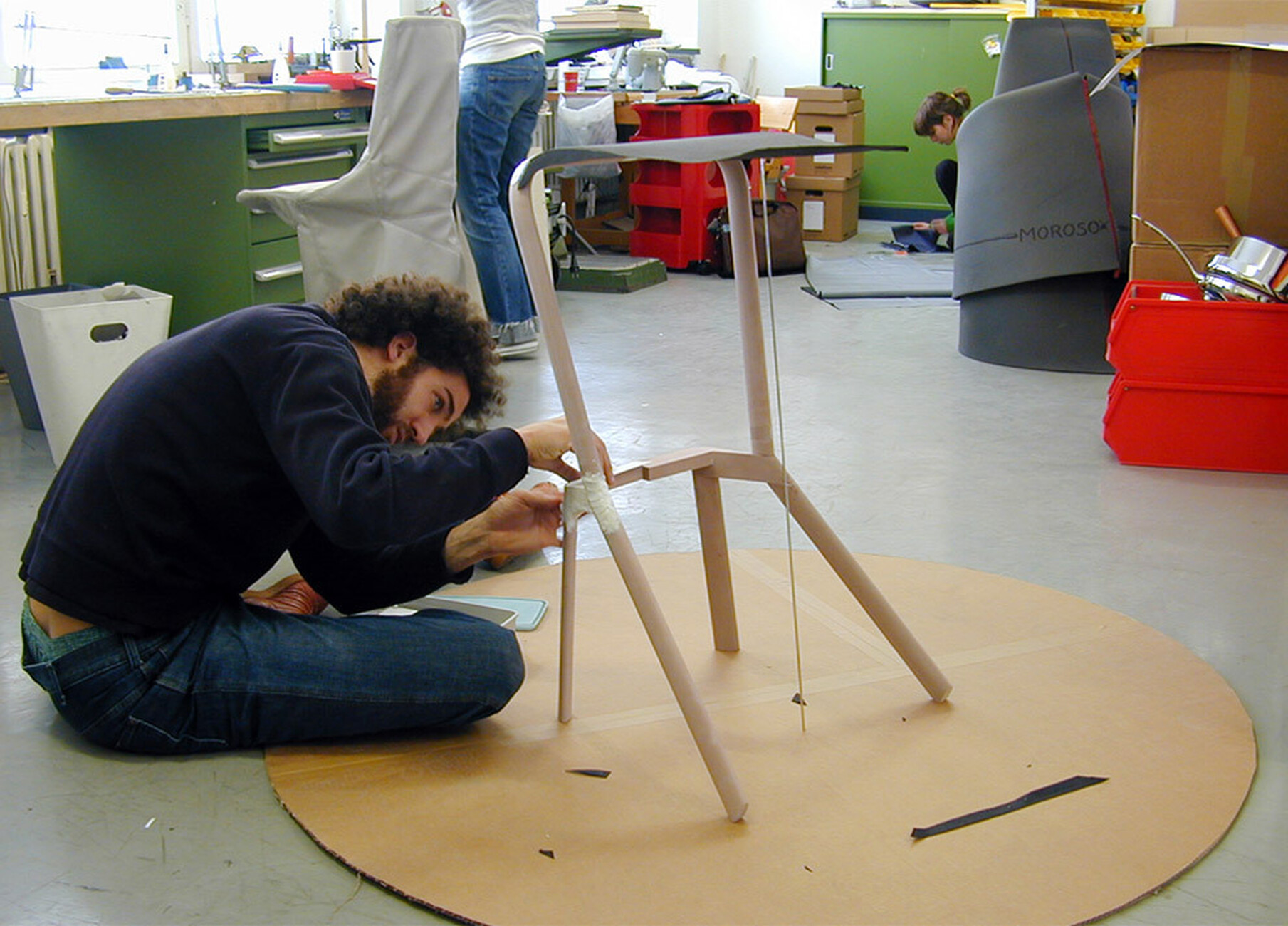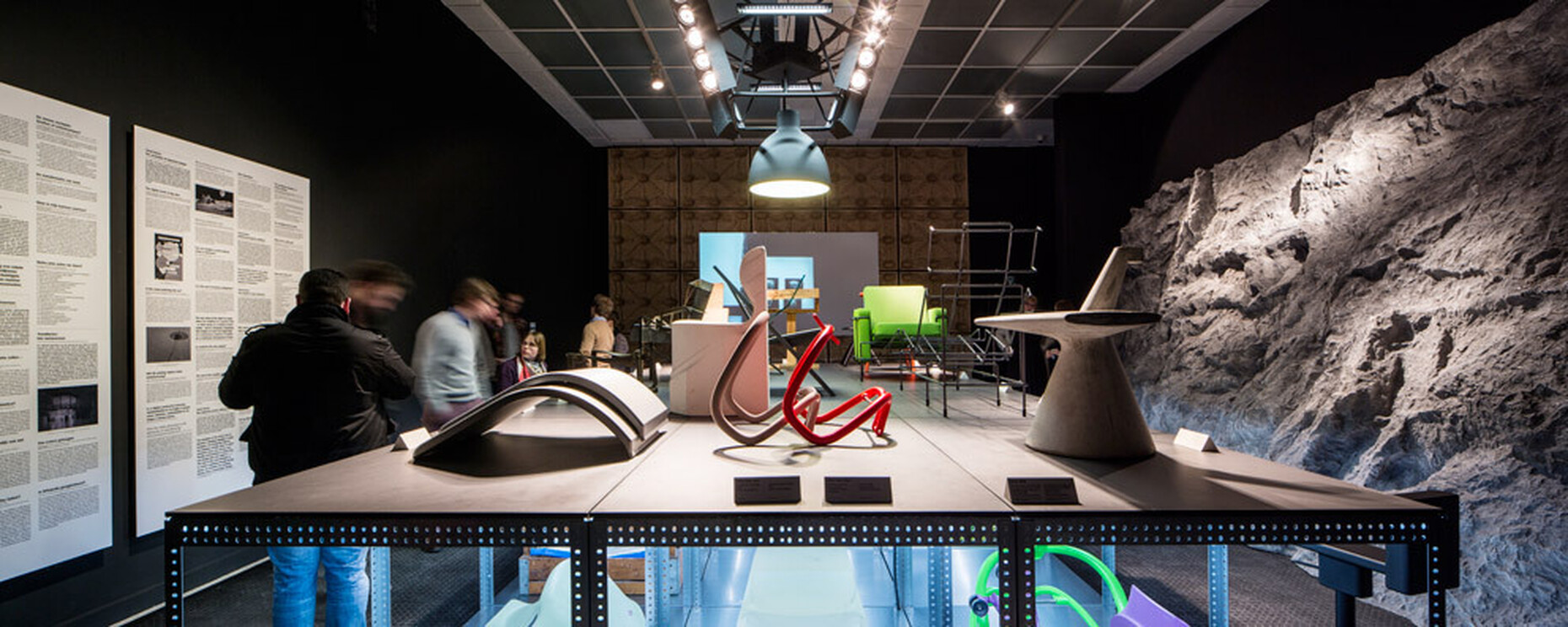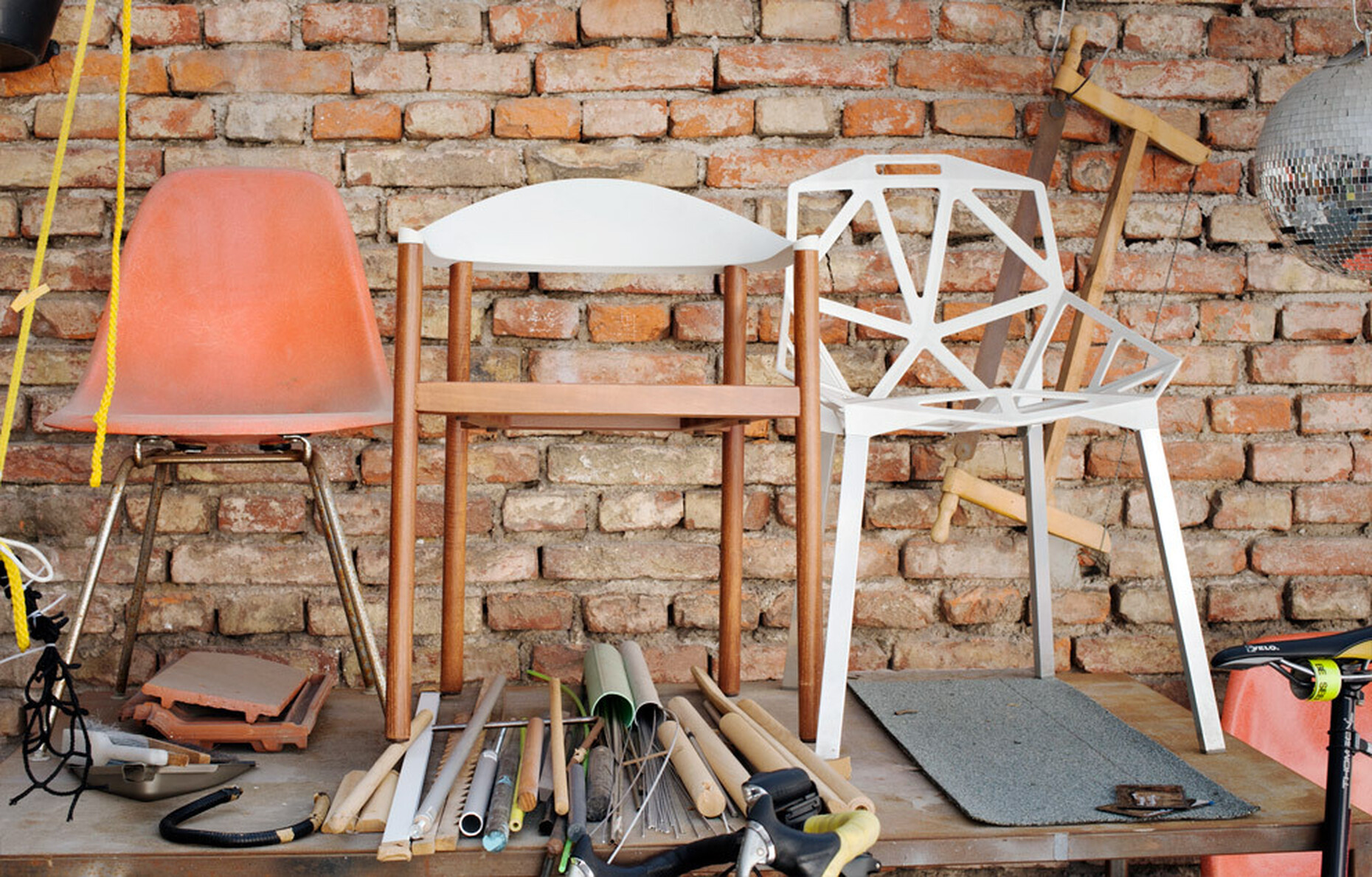Stylepark-Special: Retrospective: Konstantin Grcic in conversation – part 1
Hieronymus at the airport
Thomas Wagner: Why did you pick "Panorama" as the title for your current exhibition?
Konstantin Grcic: We came up with the idea of calling the exhibition "Panaroma" when developing a concept for the Third Space, which likewise includes a panorama. This acted like some kind of key and ultimately led to the title. Up until we had been using "Future Perfect" as the working title. As it turned out, we couldn’t use it because Lisbon suddenly had an architecture triennial of the same name. I didn’t mind too much. To me, words like "Future" carry too much baggage, and so I didn’t want to include them in the title. "Panorama", on the other hand, makes direct reference to the circular image in the Third Space, and even if it didn’t the title still works well for an exhibition: A panorama describes a particular point of view, and a very open one at that. One that invites you to look around, not just straight ahead at what’s in front of you, meaning you notice less important things on the fringes. This appealed to me instantly. There is something romantic, something very soft about this word.
It also conjures up images of those expansive painted panoramas of the past, which offer the beholder a magnificent panoramic view within a confined space; the kind of aspect you otherwise only get looking down from a church spire or a watchtower.
Konstantin Grcic: Yes, it’s exciting that this notion of space has been enjoying such a revival in recent years, for example in Berlin, at Checkpoint Charlie, where they have reconstructed a Berlin Wall scene from 1976; it’s amazing stuff, really out of this world. Despite today’s abundant technological possibilities you suddenly find yourself face to face with a panorama once again.
What do you find so interesting about a painted panorama?
Konstantin Grcic: I like the physical or analog element to it. At first I had this idea of getting a large painting made, by a professional painter who also does cinema billboards. Few people have the right skill-set to do this nowadays. What I had in mind: the painterly quality, the image composition that goes hand in glove with craftsmanship – there is something very charming about this. Today this process obviously no longer involves a brush and a canvas, but a computer and the necessary software.
The ambivalence between analog and digital design processes is part and parcel of the modern world. And it is part of your work. On the one hand, it’s the way things are done today, on the other, you have often said: Sure, but maybe things could be done in a radically different manner?
Konstantin Grcic: I am actually interested in both sides of the coin. Of course I want to know how things are done today. But I don’t feel under any pressure to have to keep abreast with the latest trends. I think we automatically become familiar with cutting-edge technologies – by working. You pick these things up "on the job", as it were. And when working on particular projects you need to strike a healthy balance regarding the possibilities offered by technology: What technology is most appropriate? How does it benefit the project? There is such a diversity in what we do; it defies being pigeonholed in terms of rules. The only rule is that with every new project you need to find the technology best suited to the task. For my generation the analog world continues to be formative, which is why it’s so important for me. I take great satisfaction from working with real things. I find exciting the digital world...
But?
Konstantin Grcic: Yes, exactly, there has to be a "but". Which is that I didn’t acquire these things the same way I did others. Which is why I don’t use them with the same ease but instead regard them as a kind of score that I can play around with. Mind you, if it had really mattered to me I probably would have gone to the trouble to learn it. As it is, I am keeping an eye on trends and in some cases I then delve into the details. In the studio we use the latest digital tools of course.
Some people say by simply looking at a chair you can tell the program used to design it. Is it true? Are you actually able to see this? And does it really matter which tool has been used? In the past no one would have bothered to find out if the designer used a paper model or a jigsaw or a bandsaw.
Konstantin Grcic: No, it’s not a criterion. I believe the important thing is to look at designs without evaluating them. On the other hand, looking at things in detail can also be very fascinating. Designers always decide for themselves how they wish to work. Making deliberate use of digital tools and sounding out the possibilities they afford you, designing things on-screen – that’s all very appealing no doubt. The crucial thing for me: Do you consciously opt for a particular technology or is it laziness? Sadly the industry we are talking about – one need only think of the Milan Furniture Fair! – expects a huge number of things to be done superfast, and the computer comes in handy to produce something on a whim. If the initial proposal is deemed good enough, the data are transmitted and something is created, albeit without any loop allowing the actual 3D result to be checked, cross-checked, tweaked and advanced. I’m not concerned about the loss of craftsmanship here; that said, the physical act of working on a model slows down the entire process, which I find very helpful. When it comes to furniture or objects and their dimensions we work on a one-to-one scale on something proper, in 3D, meaning that even at the earliest model stage you work on an actual object that is perceived in a particular context. And that makes a huge difference compared to working at a PC. The virtual workspace is an empty, abstract space, and there is a shift in perspective, which can lead to mistakes. We have likewise made them and learned things the hard way. When modelling in 3D programs you adopt a perspective from far below. By contrast, furniture proper tends to be perceived from above, taking a slight top view. When designing the Miura stool we had to do a lot of modelling on the computer, and after a while the things started to look pretty good – on screen. But when we had the built model in front of us we had to admit: It’s pretty top-heavy. At first we didn’t really know what had happened, whether the data had been transmitted incorrectly, for example. Eventually we placed the model on a table – and at that moment it looked just right. Suddenly the angle from which we saw the stool was in line with what was the default setting working at a screen – crazy.
So you are saying that different tools, whether digital or analog, produce different perspectives. And you can tell from the object which perspective was used in the design. Does this equally apply to "Panorama"? What perspective did you adopt in creating the exhibition? Which point of view of the beholder did you assume?
Konstantin Grcic: What I like about the panorama perspective is that it represents a surround view, including to the left, right, front, back, top and bottom.
So the beholder is at the center of things?
Konstantin Grcic: Yes, right at the center. There isn’t just one perspective – there are many perspectives. Which includes glancing sideways, looking back even, which not only entails looking back in time, but gazing at the side scenarios of our own existence: Suddenly you begin to see the bigger picture, which fits in with …I don’t mean to say my work or the way in which I work, but essentially I find this exciting. There is so much that interests me in connection with my work – including things that don’t fit. It’s like this: I don’t simply look at what fits in with my philosophy or my understanding of design; I take an interest in a lot of other things, too. How I process these impressions, the form that gives them meaning, is not something you can easily pinpoint, but it’s important to me to see things and have them in front of you. That was the aspect that appealed to me most in choosing “Panorama” as the title.
Even our range of vision is wider than 180 degrees. We notice more than what is in front of us, quite regardless of our imagination, beliefs or expectations for the future.
Konstantin Grcic: The fact that the notion of "future" became part of our debate was a key stimulus during the conceptual process. The future is not only in front of us, it is also closely bound up with what is behind us. Much of what is in the past is permeated by the future. I’d like to be able to take a much clearer stance, and yet I find myself forced to be noncommittal because that too is a problem of our time. Not committing yourself to something is the reality. Something could be like this, but it could also be like this, so it’s impossible to make a clear statement about "the future". Committing to something is easier in particular scenarios. So if I’m saying I’m not happy with this lack of commitment I need to start being specific.
In other words, by developing a very specific "live space"?
Konstantin Grcic: For example. That is where things become specific, maybe even exemplary, albeit fully aware that the statement such a room represents cannot apply universally. I’m not saying: That’s the way it should be. I am asking: What if ...? And so we work our way through this particular scenario. There is a particular space, how can we describe it using specific details?
What did you find particularly surprising when exploring the issue of how we could potentially live?
Konstantin Grcic: I felt that the view of the airport, in other words the location, is the most powerful element in the entire picture. That’s the moment where things don’t match. But I say: That’s the way it is. There’s a window, and outside this window there’s an airplane. But inside the space itself there is nothing, which is quite confusing.
Different functions have been integrated into this space, which is not really surprising. Do you agree?
Konstantin Grcic: Yes, the use of technology is something normal, including the modules, none of this is new. It’s solely the view from the window that changes the setting. A different photo capturing a different section would once again change the scene dramatically.
This view of the airport – how much precision and how much symbolism does it convey to you?
Konstantin Grcic: We didn’t find this photograph but we searched for it deliberately. The way I see it, it’s about different aspects you can consider positive or negative: Where do we find available living space? We know from the major cities what it’s like to be pushed out to the outskirts, to the fringes, to those non-places. When I see where my friends in London (I lived there myself 20 years ago) are living today, it would have been inconceivable during the time I was there. We would have said: Why on earth should I want to live there? I might as well leave London altogether. But today that’s the way things are, it has become a reality. The view of the airport is the bold attempt to find an image to express this. People recognize it at once, it is something that grabs you and stays on your mind.
What we perceive as metaphorically, indeed perhaps even as provocative, in actual fact describes a tangible trend in the major cities?
Konstantin Grcic: For me the airport is a very conscious choice. If you take a positive approach it could in fact be the place you might choose for its ideal infrastructure. You have everything you need on your doorstep 24/7 – shopping centers, restaurants, car rentals. The airport is a well-functioning organism and an international hub into the bargain. You can be reached easily and travel to different destinations. So you might develop this notion of a new man who thinks: "For me this is not a non-place, and living here is a sheer necessity because I can’t afford anything in the city. I want to live here because it offers me abundant opportunities."
In your opinion, does the airport today have the same function places such as the Chelsea Hotel in New York once had for artists?
Konstantin Grcic: Yes, maybe so. I hadn’t even thought of the parallels. But in the 1970s the Chelsea Hotel was quite an extraordinary place. The artists moved in there because it offered them everything they needed. On the other hand there was this charming aspect of: "I don’t need to care about anything, the lease, housekeeping, and all that stuff." You simply exploit an existing structure.
And what is St. Hieronymus doing at the airport? I’m a great admirer of Antonello da Messina and so I was very pleased to see his painting being placed in a new context. Hieronymus at the airport – is this what our future will look like? Are we all knowledgeable individuals based at this hub that potentially connects us with the whole world and yet locked into our own enclosures?
Konstantin Grcic: Yes, it’s precisely what the scholar has to accomplish – concentration and retreat, while still maintaining a link to the world, to everything that’s happening around him.
So Hieronymus at the airport would be an adequate description of our situation?
Konstantin Grcic: Yes, it’s brilliant. The whole thing fell into place somehow; it wasn’t planned, but it turned out just right.
And what about work? "Work Space" was less of a surprise to me, whereby some details and aspects lingered with me for a while. Put in very simple terms you could say: It’s the servers that do the actual work. The work process happens on the screens, resulting in things similar to those you have developed. Hieronymus is sitting at the airport trying to put everything together. And far below, at the bottom of the rock, in the cave, the servers are at work. Is that so?
Konstantin Grcic: For me Man is still present in the space, and the way I see it he is still visible, because after all things continue to be analog. This Second Space in the exhibition was intended to represent my work, and one essential characteristic of my approach is that we work the way we work. There are models, prototypes, etc. Personally, for me a studio also has to function as a “workbench”. At the same time there are computers, servers and processing power assisting us in what we do. We are highly aware that this reality exists and in fact other designers avail themselves of these tools far more than I do. And then I think: Has the author perhaps already been replaced by an algorithm? Is the manufacturing process taking place somewhere completely different? Is production veering increasingly into the virtual realm? There are plenty such things. And we have long since accepted them. And still I think: It is us who are the creative minds, nothing will replace us anytime soon, even if you find yourself confronted with doubts right away. Of course one day there will be an algorithm and software destined to take the place of what we are seeking to achieve.
We are fascinated by the possibilities and at the same time we worry about the consequences. For instance if someone says: Why do people still bother writing novels? Computer programs do a much better job.
Konstantin Grcic: Yes, exactly.
There has been a lot of talk about the "death of the author". Is this debate now making a return under technological and commercial aspects?
Konstantin Grcic: There is a lot more to the design process than the author. Here again we have the aspect of open source, meaning that all those involved in the design process keep changing. There are convincing examples for both sides to the story. Of course the processing power of modern computers enables us to work more quickly and with greater precision. You get to play around with things. And many heads tend to be better than one. Yet, and this is crucial for me, this is not about new technological opportunities radically replacing the old and superseding the tried-and-tested. Rather, a new reality is being added, creating more possibilities. At the end of the day each of us has to decide for ourselves what they want to take on board. The author has to adapt to new technologies in what he does or find a niche that makes him irreplaceable or his individual skills mean he can achieve far more than any program ever could.
That’s all well and good. But aren’t things exacerbated by the fact that nowadays not only do we all strive to be authors – but can in fact be authors?
Konstantin Grcic: Well, in theory, yes.
In times of open source and 3D printing this is also quite convenient. True to the motto: Why is it only Konstantin Grcic gets to make chairs? I too want to make a chair, so off I go and make a chair.
Konstantin Grcic: Yes, exactly. Of course anyone can make a chair, and that’s fine by me. I don’t feel threatened by it at all. I’m convinced these trends will start to fade out again in due course.
So things will ease down, will level off, will somehow be negotiated?
Konstantin Grcic: Exactly. We have mentioned literature. Graphic design was the first discipline to have come under threat from the introduction of personal computers and desktop publishing. Today we can all have a go at it ourselves – and that’s what it looks like. Which is why we still need graphic designers, specialists, because for one they have a far better and more detailed knowledge of their profession than the amateurs, and a lot more expertise into the bargain. I like the idea of specializing, but not in the sense of someone having tunnel vision or blinkers, but that compared to the amateurs, the experts have far greater knowledge and skills precisely because they are experts.
So the democratization of all processes is not going to be the downfall of specific knowledge and expertise?
Konstantin Grcic: Not at all. We still need specialists because thanks to their knowledge and experience they can be more flexible and diverse – by way of getting back to the designer’s job profile or profession, in other words my league, through the back door. It is those skills that are expected of us today and that set us apart. Today we are in a position to accomplish so much more – we are so much more than just designers. I not only design a chair, I do all of the planning too. What kind of chair is suitable for which situation? In the context of a particular company, whose history, options and market I know well. Our work begins far earlier, and has a far broader scope, and touches on a whole host of other things before we finally get to the design stage, which is equally important of course. Or: All these other things are necessary to be able to design a chair in the first place – for a company that has its very own history and so on. I believe that when it comes to these aspects our work has fundamentally changed, and that is something I see rather positive.
Konstantin Grcic – Panorama
through May 24, 2015
Z 33 House for Contemporary Art
Zuivelmarkt 333500
Hasselt / Belgium































